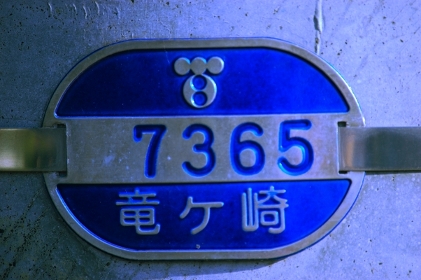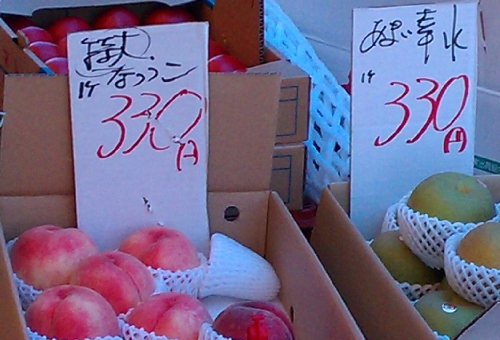
 |
| A Tepco sign: 竜ケ崎 (Ryūgasaki) |
|---|
The small character ヶ found in the names of places like Kasumigaoka (霞ヶ丘) and in words like ikkagetsu (一ヶ月), "one month", looks like a small version of the katakana ke character ケ. However, it is pronounced ka, ko, or ga, not ke.
 |
| Peaches and pears one for 330 yen - 1ヶ330円 |
|---|
This ヶ is an abbreviated form of the kanji 箇. Its shape is based on the top left part of the kanji. This abbreviation is used when the kanji is used as a counting word, josūshi (数助詞). For example, it might be seen on a price sign for fruit such as ikko hyaku en (一ヶ100円), "one piece of fruit for one hundred yen", when it's pronounced ko. It is also used in counting periods of months, such as sankagetsu (三ヶ月), "three months", when it's pronounced ka. (See What is the counter for ...? for more on Japanese counting words.)
In place names, the small ヶ is used to write the connective particle が in place names such as Kasumigaoka (霞ヶ丘). Confusingly, the same connective particle is also often written with a full-sized katakana ke, ケ, as in Ryūgasaki-shi (龍ケ崎市) [Ryugasaki, a city in Ibaraki Prefecture] or with a hiragana ga, が, as in Jiyūgaoka (自由が丘), a subdivision of Tokyo's Meguro Ward.
This answer was compiled referring to posts by Mike Wright, Bart Mathias, and Lei Tanabe.
Copyright © 1994-2025 Ben Bullock
If you have questions, corrections, or comments, please contact Ben Bullock or use the discussion forum / Privacy policy

|

|

|

|

|
| Book reviews |
Convert Japanese numbers |
Handwritten kanji recognition |
Stroke order diagrams |
Convert Japanese units |